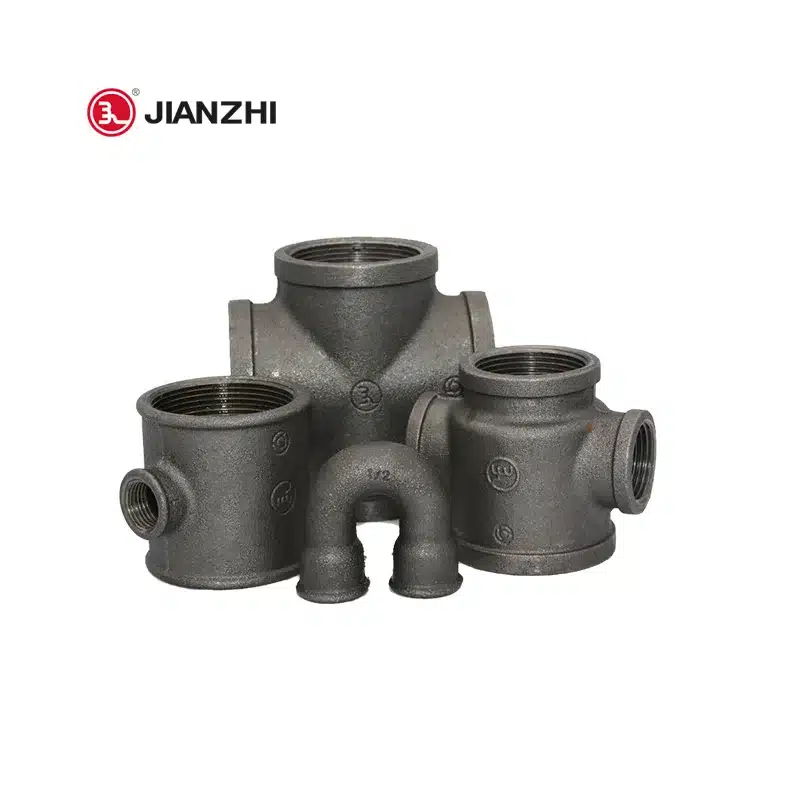Galvanized malleable iron pipe fittings provide a robust and corrosion-resistant solution for plumbing and pipeline systems. Their strength, durability, and ease of installation make them ideal for various applications, from residential plumbing to commercial and industrial projects. The protective zinc coating enhances the fittings’ resistance to rust and corrosion, ensuring reliable performance and longevity.
Understanding Galvanized Malleable Iron Pipe Fittings

A. Composition and Manufacturing:
Malleable Iron: China sGalvanized malleable iron pipe fittings are made from malleable iron, which is created by annealing white cast iron. This process enhances the iron’s ductility and toughness, making it easier to shape and form into fittings.
Galvanization: The fittings are then coated with a layer of zinc through a process known as galvanization. This protective zinc coating provides excellent corrosion resistance, extending the lifespan of the fittings.
B. Types and Sizes:
Range of Fittings: Galvanized malleable iron pipe fittings are available in a wide variety of types, including elbows, tees, couplings, unions, crosses, and more. These fittings allow for flexible and efficient plumbing system designs.
Size Range: The fittings are manufactured in various sizes, typically ranging from 1/8 inch to 6 inches, allowing for compatibility with different pipe diameters and systems.
Benefits and Advantages
A. Strength and Durability:
High Strength: Galvanized malleable iron pipe fittings exhibit exceptional strength, providing reliable and secure connections in plumbing systems. They can withstand high pressure and resist mechanical stresses, ensuring long-term performance.
Durability: The combination of malleable iron and the galvanized zinc coating enhances the fittings’ durability, making them resistant to wear, impact, and external elements. This durability translates into reduced maintenance, fewer replacements, and cost savings over time.
B. Corrosion Resistance:
Zinc Coating: The galvanized zinc coating on malleable iron pipe fittings acts as a protective barrier, preventing direct contact between the iron and corrosive elements like moisture and chemicals. This coating significantly reduces the risk of rust and corrosion, even in demanding environments.
Longevity: The corrosion resistance provided by the zinc coating enhances the fittings’ lifespan, making them suitable for both indoor and outdoor applications. They can withstand exposure to moisture, humidity, and various atmospheric conditions without compromising their performance.
C. Ease of Installation and Versatility:
Easy to Install: Galvanized malleable iron pipe fittings are designed for ease of installation. They feature threaded connections that enable quick and straightforward assembly, eliminating the need for complex welding or specialized tools.
Versatile Applications: These fittings find extensive use in a wide range of applications, including plumbing systems, water supply networks, irrigation systems, oil and gas pipelines, and industrial installations. Their versatility makes them suitable for both residential and commercial projects.
Applications and Considerations
A. Plumbing Systems and Water Supply Networks:
Residential Plumbing: Galvanized malleable iron pipe fittings are commonly used in residential plumbing systems for connecting pipes, fixtures, and appliances. They provide secure connections and reliable water flow.
Commercial and Industrial Applications: These fittings are also utilized in commercial buildings, industrial facilities, and municipal water supply networks. They offer robust connections, withstand high pressures, and ensure efficient water distribution.
B. Considerations:
Compatibility: When selecting galvanized malleable iron pipe fittings, it is essential to ensure compatibility with the pipe material and system requirements. Proper sizing and thread compatibility are critical for seamless installation and leak-free connections.
Maintenance: While China galvanized malleable iron pipe fittings offer excellent corrosion resistance, periodic inspection and maintenance are necessary to ensure their long-term performance. Regular checks for signs of wear, damage, or corrosion should be conducted to address any issues promptly.
